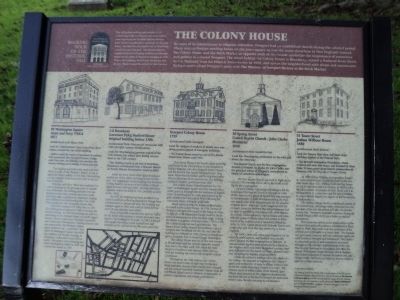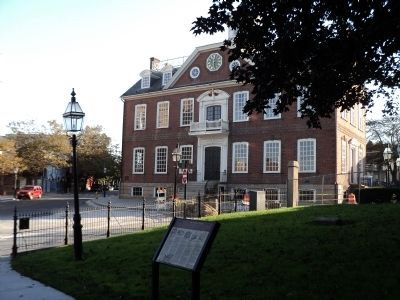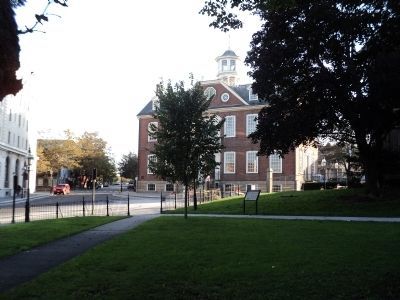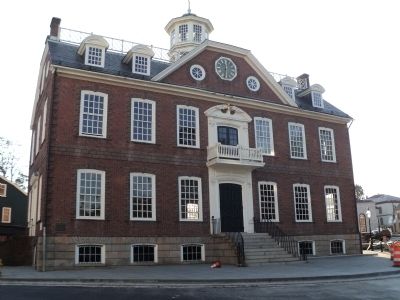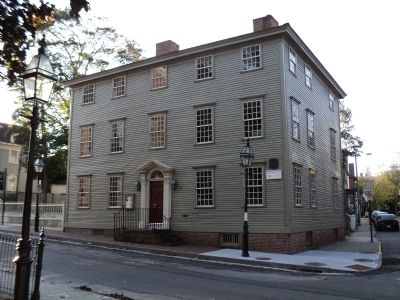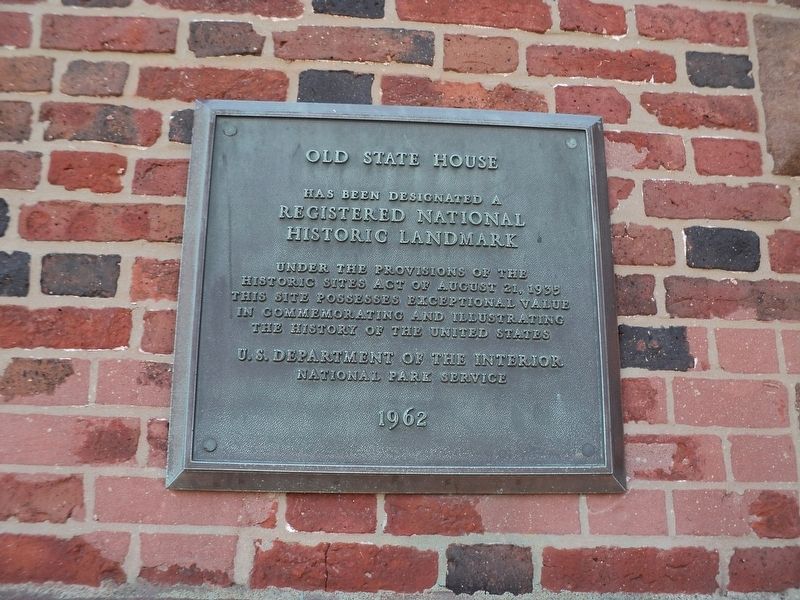Newport in Newport County, Rhode Island — The American Northeast (New England)
The Colony House
Because of its commitment to religious toleration, Newport had no established church during the colonial period. There was no Puritan meeting house on the town square as was the norm elsewhere in New England. Instead, the Colony House and the Brick Market at opposite ends of the Parade symbolize the importance of commerce and politics in colonial Newport. The street behind the Colony House is Broadway, named a National Main Street by the National Trust for Historic Preservation in 1998, and serves the neighborhood with shops and restaurants. To learn more about Newport’s past, visit The Museum of Newport History at the Brick Market.
50 Washington Square
Army and Navy YMCA
1911
Architectural style : Beaux Arts
Look for : Polychromatic terra cotta frieze decorations around the top of the building.
• Built to serve the needs of thousand of enlisted Navy personnel after Newport became a large scale Navy port, the building now provides low income housing and a variety of social services.
This building was built as the Army and Navy YMCA as a gift of Mrs. Thomas J. Emery. It was designed by Louis E. LaBacle of New York. This building is a rare example of the Beaux-Arts style in this section of Newport.
The Army and Navy YMCA was established in 1903 in response to the growing needs of enlisted men in Newport. The building included over one hundred rooms where military personnel could spend the night, a gymnasium, restaurant, reading room, billiard room and bowling alley. Use of the YMCA peaked in 1951 during the Korean War.
The YMCA moved to the Navy base in 1973. The building was re-opened in 1980 to become low income housing. In 1987, the building was sold to a partnership of two Newport-based non-profit organizations, Church Community Housing Corporation and Community Development Training Institute, and was renovated by the Newport Collaborative Architects, Inc., a local firm. Now called 50 Washington Square, the building combines low-income housing, an emergency shelter and a social service facility. The project won a Housing and Urban Development Award in 1990, and a Fannie Mae award in 1995.
2-6 Broadway
Governor Peleg Sanford House
Original Building before 1700.
Architectural Style : First period vernacular with 19th and 20th century modifications.
Look For : Overhanging garrison typical of the 17th century, but added here during renovations in the 19th century.
• This building stands at the foot of Broadway. Broadway’s revitalization won a Newport Historical Society Historic Preservation Award in 2000.
Inside the more recent shell of this building is nestled one of the oldest surviving
houses in Newport. The original part of the building was the home of Peleg Sanford, Governor of the Colony of Rhode Island between 1680 and 1683. He built this house sometime before his death in 1701, probably as early as the 1640s.
By 1827, the building had been modified to include a storefront, reflecting Broadway’s change from a residential to a commercial area. The building was enlarged again in 1845, and a mix of Greek Revival and Colonial elements were added.
Many Newporters remember the store as “Lalli’s” for the family that operated a variety store and stand in this building for 63 years. In 1923, P. Joseph Lalli bought the tobacco store located here and members of the Lalli family ran the store until 1986.
Newport Colony House
1739
Architectural Style : Georgian
Look for : Initials of workers in lintels over windows; portico typical of Georgian buildings.
• The Colony House served as one of five Rhode Island State Houses until 1901.
The Colony House is the fourth oldest surviving state house in the United States. It was designed by Richard Munday, who also designed Trinity Church and the Seventh Day Baptist Meeting House. Benjamin Wyatt was the builder and he employed many African-Americans in its construction. The building replaced a smaller courthouse from 1687.
The Colony House helped transform the “Parade,” as Washington Square was then named, into a public space in keeping with the traditions of English cities. It was designed in a style popularized by English architect Sir Christopher Wren following the customary layout of English guild halls.
Many events during the American Revolution occurred at the Colony House. In 1766, citizens of Newport celebrated the repeal of the Stamp Act here. On July 20, 1776, Major John Handy read the Declaration of Independence from the front steps. During the British occupation of Newport from 1776 to 1779, the Colony House was used as a barracks. The French forces, led by General Rochambeau, came to Newport after the British left the city, and used the building as a hospital. In 1782, General Rochambeau gave a reception here to honor George Washington.
The Colony House was one of five state houses in Rhode Island and the General Assembly rotated from one to the other until 1901 when the State House in Providence was opened. From 1901 to 1926 the building was used as the Newport County Courthouse.
Throughout the 19th century, the Colony House was used in May of each year for Election Week festivities, during which returns were counted and the General Assembly convened. Visitors from all over Rhode Island came to Newport to participate in political negotiations and victory celebrations.
51 Touro Street
Joshua Wilbour House
1850
Architectural Style : Federal
Look for : Square floor plan and three story elevation typical of the Federal Style.
• The Newport Restoration Foundation, which restored and owns this house, was founded by Doris Duke. To learn more about historic preservation in Newport visit The Museum of Newport History.
In 1800 Joshua Wilbour, a housewright, bought an undeveloped corner lot that had been in the Rodman family since 1711. Wilbour built this fine house on the lot and then sold it in October of 1802 to John Wood, a mariner. In January of 1809, Wood sold it to William Ellery, Jr., a merchant and the son of William Sr., one of Rhode Island’s two signers of the Declaration of Independence.
The Wilbour House shows a less formal version of the Federal Style, and brings earlier elements from the Georgian styles into the period well after the Revolutionary War. Newport’s depressed economy during the Federal Period (1790-1810) put a brake on stylistic innovations.
This house has served as the headquarters of the Newport Restoration Foundation, established by Doris Duke in 1968. Miss Duke took the restoration of the colonial part of Newport to a heroic level. The Foundation purchased, restored, and now maintains eighty-six early houses in Newport and Portsmouth. They form an important group of well-maintained structures throughout the colonial neighborhoods of the city. The Newport Restoration Foundation also owns the Samuel Whitehorne House Museum which displays Miss Duke’s collection of colonial decorative arts, and “Rough Point.” her home on Bellevue Avenue which is open as a house museum.
Topics and series. This historical marker is listed in these topic lists: Colonial Era • War, US Revolutionary. In addition, it is included in the National Historic Landmarks series list. A significant historical month for this entry is January 1809.
Location. 41° 29.408′ N, 71° 18.806′ W. Marker is in Newport, Rhode Island, in Newport County. Marker is on Washington Square, on the right when traveling east. Marker is located at the northeast corner of Washington Square. Touch for map. Marker is in this post office area: Newport RI 02840, United States of America. Touch for directions.
Other nearby markers. At least 8 other markers are within walking distance of this marker. Washington Square (a few steps from this marker); The Colony House / The State House (within shouting distance of this marker); Eisenhower Park (within shouting distance of this marker); Wilbour-Ellery House (within shouting distance of this marker); Perry (within shouting distance of this marker); Buliod-Perry House (about 300 feet away, measured in a direct line); The Famous Letter by President George Washington
(about 300 feet away); The Letter from Moses Seixas (about 300 feet away). Touch for a list and map of all markers in Newport.
More about this marker. Pictures of the Army Navy YMCA, Gov. Peleg Sanford House, Colony House, United Baptist Church, and Joshua Wilbour House appear at the top of the marker. The lower left features a map of the Walking Tour of the Historic Hill in Newport.
Credits. This page was last revised on June 16, 2016. It was originally submitted on October 20, 2011, by Bill Coughlin of Woodland Park, New Jersey. This page has been viewed 904 times since then and 18 times this year. Photos: 1, 2, 3, 4, 5. submitted on October 20, 2011, by Bill Coughlin of Woodland Park, New Jersey. 6. submitted on October 9, 2011, by Bill Coughlin of Woodland Park, New Jersey.
